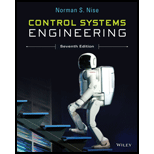
Concept explainers
Use MATLAB to generate the partial fraction expansion of the following function: [Section: 2.3]
Want to see the full answer?
Check out a sample textbook solution
Chapter 2 Solutions
Control Systems Engineering
- To create AutoCAD Q: Use the principle of the geometric model shown in the following figure? R8 16 22 50 015 50 425 40 80 20 rarrow_forwardWrite MATLAB code to perform the following math expression: a) X=7, a=X+2 5 12 2 b) A= 22 L27 4 48 7arrow_forwardGiven the trasnfer function G(s) numerator and denominator coefficients for Matlab code should be: O s³+2s+1 2s4+2s²+1' the num= [1 0 2 1] and den=[2 020 1] O num=[1 2 1] and den=[2 0 2 1 1] O num=[1 2 1] and den=[2 2 1] O num=[1 0 2 1] and den=[2 2 0 1]arrow_forward
- A velocity of a vehicle is required to be controlled and maintained constant even if there are disturbances because of wind, or road surface variations. The forces that are applied on the vehicle are the engine force (u), damping/resistive force (b*v) that opposing the motion, and inertial force (m*a). A simplified model is shown in the free body diagram below. From the free body diagram, the ordinary differential equation of the vehicle is: m * dv(t)/ dt + bv(t) = u (t) Where: v (m/s) is the velocity of the vehicle, b [Ns/m] is the damping coefficient, m [kg] is the vehicle mass, u [N] is the engine force. Question: Assume that the vehicle initially starts from zero velocity and zero acceleration. Then, (Note that the velocity (v) is the output and the force (w) is the input to the system): A. Use Laplace transform of the differential equation to determine the transfer function of the system.arrow_forwardA velocity of a vehicle is required to be controlled and maintained constant even if there are disturbances because of wind, or road surface variations. The forces that are applied on the vehicle are the engine force (u), damping/resistive force (b*v) that opposing the motion, and inertial force (m*a). A simplified model is shown in the free body diagram below. From the free body diagram, the ordinary differential equation of the vehicle is: m * dv(t)/ dt + bv(t) = u (t) Where: v (m/s) is the velocity of the vehicle, b [Ns/m] is the damping coefficient, m [kg] is the vehicle mass, u [N] is the engine force. Question: Assume that the vehicle initially starts from zero velocity and zero acceleration. Then, (Note that the velocity (v) is the output and the force (w) is the input to the system): 1. What is the order of this system?arrow_forwardMATLAB Create a script that will take a continuous function f(x) as input, plot the function on x € [-10,10] with step size of h = 0.01, and will prompt the user with the following options: • 'r+45' and 'r-45' to rotate the plot 45° counterclockwise and clockwise respectively, ● 's+45' and 's-45' to shear the plot's ĵ 45�� to the right and to the left respectively, and • 'k+45' and 'k-45' to shear the plot's ↑ 45° upwards and downwards respectively.arrow_forward
- Response using matlab.arrow_forwardA projectile is launched with a velocity of 100 m/s at an angle of 30° above the horizontal. Create a Simulink model to solve the projectile's equations of motion, where x and y are the horizontal and vertical displacements of the projectile. X=0 x(0) = 100 cos 30º x(0)=0 ÿ=-g y(0)=0 y(0)=100 sin 30º Use the model to plot the projectile's trajectory y versus x for 0≤t≤10 s.arrow_forwardsole using laplace transforms Do not answer in image formatarrow_forward
- R$ RL V (t) V(t) L Figure 7: A tuning circuit for radio 5. Figure 7 shows a tuning circuit used in radio. Derive the state equation using the linear graph approach. Also let the output variable be the voltage vo(t). Derive the output equation.arrow_forwardMATLAB Create a script that will take a continuous function f(x) as input, plot the function on x € [-10,10] with step size of h = 0.01,, and will prompt the user with the following options ● 'r+45' and 'r-45' to rotate the plot 45° counterclockwise and clockwise respectively, 'j+45' and 'j-45' to shear the plot's 45ĵº to the right and to the left respectively, and • 'i+45' and 'i-45' to shear the plot's 457° upwards and downwards respectively.arrow_forwardSolve the initial value problem. y" + 4y' + 20y = 0: y(0) = 2 y (0) = - 3 %3D Chapter 6, Section 6.2, Go Tutorial Problem 12 Find Y(s). 2s + 5 Y(s): s2 + 4s + 20 2s + 5 Y(s) = s2 + 4s + 20 2s – 5 Y(s) : + 4s + 20 2 + 4s + 20 Y(s) 2s + 5arrow_forward
 Elements Of ElectromagneticsMechanical EngineeringISBN:9780190698614Author:Sadiku, Matthew N. O.Publisher:Oxford University Press
Elements Of ElectromagneticsMechanical EngineeringISBN:9780190698614Author:Sadiku, Matthew N. O.Publisher:Oxford University Press Mechanics of Materials (10th Edition)Mechanical EngineeringISBN:9780134319650Author:Russell C. HibbelerPublisher:PEARSON
Mechanics of Materials (10th Edition)Mechanical EngineeringISBN:9780134319650Author:Russell C. HibbelerPublisher:PEARSON Thermodynamics: An Engineering ApproachMechanical EngineeringISBN:9781259822674Author:Yunus A. Cengel Dr., Michael A. BolesPublisher:McGraw-Hill Education
Thermodynamics: An Engineering ApproachMechanical EngineeringISBN:9781259822674Author:Yunus A. Cengel Dr., Michael A. BolesPublisher:McGraw-Hill Education Control Systems EngineeringMechanical EngineeringISBN:9781118170519Author:Norman S. NisePublisher:WILEY
Control Systems EngineeringMechanical EngineeringISBN:9781118170519Author:Norman S. NisePublisher:WILEY Mechanics of Materials (MindTap Course List)Mechanical EngineeringISBN:9781337093347Author:Barry J. Goodno, James M. GerePublisher:Cengage Learning
Mechanics of Materials (MindTap Course List)Mechanical EngineeringISBN:9781337093347Author:Barry J. Goodno, James M. GerePublisher:Cengage Learning Engineering Mechanics: StaticsMechanical EngineeringISBN:9781118807330Author:James L. Meriam, L. G. Kraige, J. N. BoltonPublisher:WILEY
Engineering Mechanics: StaticsMechanical EngineeringISBN:9781118807330Author:James L. Meriam, L. G. Kraige, J. N. BoltonPublisher:WILEY





